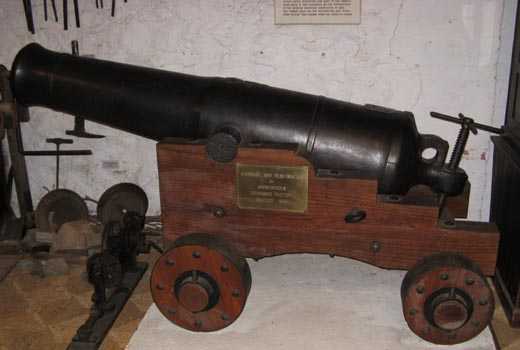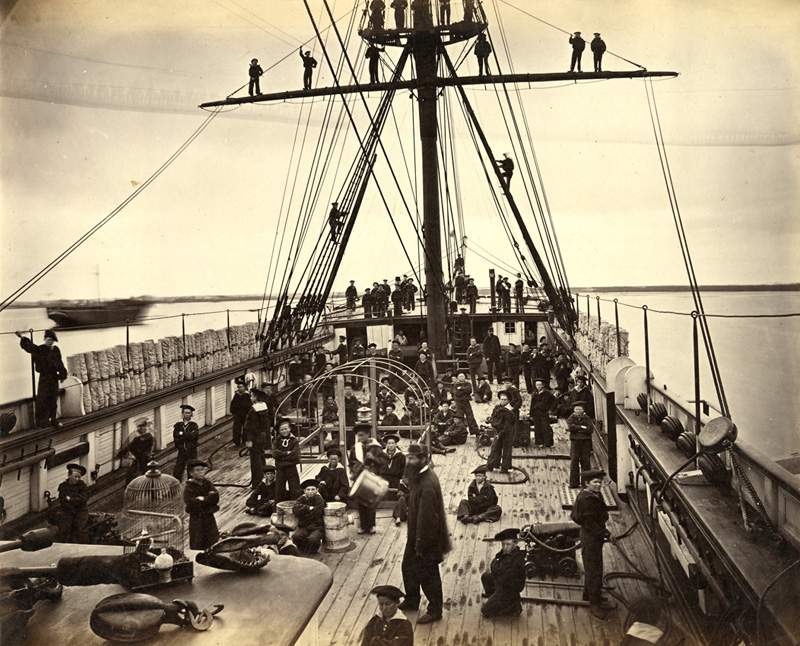
"The expenditure of some thousands of pounds of the public money in patching up an old hulk like the Sir Harry Smith into a blockship is a Government blunder, if not indeed a kind of a swindle. That portion of the community who have been labouring under alarm that the Russians should enter our harbour, destroy the shipping, pillage our city, and ransack our banks, has been lulled into apparent security by the outlay of many thousands of pounds, in the formation of a battery fixed on a site at St. Kilda, the erection of a similar means of defence at Gellibrand's Point, and the establishment of a real blockship, armed with 32 pounders and manned by the old veterans of the water-police, under the immediate supervision of a gentleman who, Punch facetiously informed its readers last week, was not a lieutenant on board the Victory at the battle of Trafalgar! It is generally understood that blockships are usually built purposely for that particular kind of defence to which they are peculiarly adapted, and that considerable care is exercised with regard to the strength and stability of the ship. The Sir Harry Smith is an old barque that is now being twisted into a kind of man-o'-war for the defence or the harbour. It is true that the Government are making the vessel as strong as possible by the introduction of new timbers, knees, &c., but it is equally clear that no alterations can make the Sir Harry Smith in any way adapted for the service she is intended. For some three or four years that vessel has been lying in the Bay, a short distance from William town, and has always been looked upon with doubtful eyes as to her soundness. For those number of years she has been grinding and grating the rocks where she was moored, and when her promotion comes forth from the hands, of Sir Charles Hotham she is subjected to no examination as to her efficiency for her new occupation, but is put into harness at once and sent forth to the public as a strong and honest craft, whereas she is a weak sad rotten impostor. If the Sir Harry Smith had fallen into private hands, common prudence would have placed her on the slip for examination. As she has continued in the hands of the Government, and as some alarmists are crying out for batteries, and forts and floating blockships she is at once placed in the bands of the carpenters with an "Oh! she will do for Australia." Will any gentleman in his place Legislative Council put the question as to the cost of this blockship, what examination has been made of her, and how she is to manned. Whether it is true that a remnant of the present water police, with the usual retinue of sub-inspectors, and useless half-land, half-sea officers are to man her? The efficiency of this means of defence of our harbour is to be kept up, we understand, partly by the force mentioned, assisted by the boatmen connected with the Customs' department, who are to undergo drill on board the blockship some once or twice a fortnight. If Victoria requires harbour defence at all-and we admit she does surely she ought not to have thrust upon her such a scandalous imposition as the one that is being introduced by way of the new blockship.- Argus, December 11."
The Sydney Morning Herald, 18 December 1855"The Water Police hulk, Sir Harry Smith, having completed her repairs, has received her stores, and taken on board the six 32-pounders she has carried since being placed in commission. She has been moored nearly midway between Williamstown and the Sandridge shore, near the penal hulks. As a block ship she would be but of little use were an enemy to appear in our waters, there being no protection on board for men while working the guns; and we repeat the recommendation that her guns be immediately landed, and placed in position in the battery at Gellibrand's Point, where there are platforms and plenty of space for them."
The Argus, 14 July 1859Letter to the Editor
".....The Sir Harry Smith, as a floating battery, is a failure. Her guns and crew would certainly be swept clean off her deck, it being so exposed as not to afford even the least shelter from the enemy's small-arm men.
Yours, &c., Kent"
Timeline | |
|---|---|
| Commercially Operated Ship | |
1852, 26 March | Commercial ship carrying passengers between Victoria1, Sydney, Hobart & New Zealand. |
1852, 19 April | Auction39. |
| Career solely as Water Police Guardship | |
1852, 13 September | Sir Harry Smith, police hulk. 31 |
1853, 28 March | Harry Smith (guard-ship). 6 |
1855, 5 February | Guardship. 3 |
| Career as Blockship* (and Water Police Guardship) | |
1855, August | Undergoing conversion to blockship with 32 pounders. 2 "Ten guns on a flush deck." 7 |
1856, 11 February | Dry docked in Saltwater River. 4 |
1856, March | "The new blockship has been moored at the outside anchorage for some weeks, and we presume is now quite ready for 'active duty.'" 19 |
1856, 27 December | Harry Smith & HMCS Victoria fired a salute to welcome Governor Barkly. 5 |
1857, 17 January | £800 for fittings for blockship Harry Smith so as to improve quarters on board for Water Police. 8 |
1859 June/July | Six 32 pounder guns removed to Railway Pier. 30 |
1859, 27 September | Naval Brigade practises aboard Harry Smith. 23 |
1860, 11 May | Towed from Williamstown moorings to outside anchorage for gunnery practise by Naval Volunteers. 42 |
1860, 24 May | First Naval Brigade Review held aboard Harry Smith. 29 |
1860, 19 & 26 October | Naval Brigade (Williamstown) drills on board Block-Ship. 33 |
1860, December | Naval Brigade (Williamstown) undertakes Great gun drill aboard Blockship on Mondays, Fridays and Saturdays. 37 |
| Naval Depot Ship | |
1861, 20 March | Tidal signals and bad weather signals displayed from masthead of Harry Smith. 18 |
1862, April | Permission given to use as a naval depot ship to store spare gun gear, machinery & sails as well as 100 tons of coal for HMCS Victoria.45 |
1863, 22 April | Shipkeeper, Mr. Griffin, living on board with family. 28 |
1864, 12 October | Height of water in Yarra river no longer indicated by tide signals on board Harry Smith. 24 |
| Career as a Naval Training Ship & 2nd period of service as a Blockship | |
August/September 1864 | During her stay, (HMS Curcoa) Commodore Sir William Wiseman inspected our means of defence, and it understood that he fully approves of the whole scheme proposed by the hon. the Treasurer, as also the building of rafts, each to carry a 68-pounder (95 cwt) gun, and the immediate equipment of a naval training and blockship. This latter vessel is now being fitted up as an arm of defence, in the form of a five-gun battery, and will be moored at the White Buoy in Hobson's Bay.41 |
1864, 14 October | Contract accepted for repairs to Sir Harry Smith training ship. £349. 21 |
1865, 20 April | Temporary Naval Training & Blockship. Commanded by Lieut. Woods. |
1865, 17 May | Industrial School on board the Naval Training Ship established to be occupied by and used for males exclusively. 22 |
1865, 16 June | Lieut. G. A. Woods appointed to command the Naval Training Ship; and also to superintendent of an Industrial School on board the same ship. 34 |
| Career only as a Naval Training Ship | |
1865, 25 October | "The vessels are the Sir Harry Smith which is used as a receptacle for young boys from the industrial schools, and the Deborah, whose inmates consist of juvenile offenders against the law....and rigged simply with two jury masts, or poles, it not being intended that she should be adapted for moving about, otherwise than with the assistance of a tug-steamer....the Sir Harry Smith was placed under command of Lieut. Wood, of her Majesty's Imperial and colonial navies, formerly of H.M.C.S. Victoria,"16 |
1866, 12 March | Four broadside guns returned from Harry Smith to Victoria. Pivot gun now at one of the shore batteries. A few brass twelve pounders for exercising purposes will soon be provided.20 |
1866, 29 March | Amongst some of the articles stolen from the wreck of the Arrow were found elegantly finished brass guns, which Mr. Leggett found planted about two miles from the wreck, and they are now on board the naval training ship at Melbourne, having been sold by him to the Victorian Government.38 |
1866, 30 September | 183 boys on board. 10 |
1867, 18 May | Proposal to transfer "establishment of the Sir Harry Smith (the training-ship off Williamstown) to the Nelson, there will be enough to keep her in order & thus those now employed in the colony will be provided for." 9 |
1867, 10 September | Sub-Lieutenant F. O. Handfield, commanding the Naval Training Ship, to be Lieutenant. 35 |
| Career as a Reformatory Ship | |
1869, 7 January 46 | Reformatory boys transferred from Deborah to Sir Harry Smith. After the transfer of the Training Ship Boy from Sir Harry Smith to Nelson in 1868, the role of Sir Harry Smith changed from that of an Industrial School to that of a reformatory. |
1870, 10 February | Fired salute on inauguration of Victorian Ensign. 11 |
1870 | Separate command dispensed with. Placed under control of Lieut. Turner of Nelson. 12 |
1870, 7 November | Arrangements were made by the Government some months since to dispense with the need of a separate command on board the juvenile reformatory ship Sir Harry Smith. As a consequence, Lieutenant Handfield leaves the Government service at the end of the year, and the Sir Harry Smith will be placed under the control of Lieutenant F.H.B. Turner, the commander of the Nelson training-ship. 36 |
1873, 31 January | Last of boys transferred to new reformatory. (Adjacent to Pentridge.) 15 |
| Sold out of Government Service | |
1873, 20 March | Government hulk Sir Harry Smith advertised for sale. 13 |
1873, 22 April | "The tender of Messrs. M'Meckan, Blackwood and Co. for the purchase of the Government hulk Sir Harry Smith, recently in use as a reformatory school, has been accepted. The sum to be paid is £575." 17 |
1873, 26 August | Referred to as a Lighter lying on the south side of the Yarra opposite Coles Wharf. 14 |
1885, 27 October | Advertised for sale by auction. 43 |
1887, 7 May | Application made to blast the hulk Sir Harry Smith, lying in Saltwater River. 44 |








* Blockship"in the mid-19th century the term blockships was applied to two groups of mobile sea batteries developed by the Royal Commission on Coast Defense. |
1 Colonial Times (Hobart), 26 March 1852
2 The Sydney Morning Herald, 18 December 1855
3 The Argus, 5 February 1855
4 Empire, 11 February 1856
5 Williamstown Chronicle, 27 December 1856
6 The Argus, 28 March 1853
7 The Argus, 20 April 1865
8 The Argus, 17 January 1857
9 The Argus, 18 May 1867
10 The Australian News for Home Readers, 20 April 1867.
11 The Argus, 10 February 1870
12 The Argus, 7 November 1870
13 The Argus, 20 March 1873
14 The Argus, 26 August 1873
15 The Argus, 31 January 1873
16 The Australian News for Home Readers, 25 October 1865
17 Illustrated Australian News for Home Readers, 22 April 1873
18 The Argus, 20 March 1861
19 The Argus, 24 April 1856
20 The Argus, 12 March 1866
21 Victorian Government Gazette, 14 October 1864
22 Victorian Government Gazette, 23 May 1865
23 The Argus, 28 September 1859
24 The Argus, 11 October 1864
25 The Argus, 16 July 1859
26 Victorian Government Gazette, 14 June 1859
27 The Argus, 14 July 1859
28 The Argus, 22 April 1863
29 The Argus, 25 May 1860
30 The Argus, 22 June 1859
31 The Argus, 13 September 1852
32 The Argus, 1 September 1852
33 Williamstown Chronicle, 13 October 1860
34 Victorian Government Gazette, 16 June 1865
35 Victorian Government Gazette, 10 September 1867
36 The Argus, 7 November 1870
37 Williamstown Chronicle, 1 December 1860
38 Gippsland Times, 29 March 1866
39 The Argus, 16 April 1852
40 The Argus, 14 October 1865
41 The Argus, 24 September 1864
42 Coal Hulks of Port Phillip Bay, Bob Leek, 2006
43 The Argus, 27 October 1885
44 Wiliamstown Chronicle, 7 May 1887
45 Victoria. A History of Her Majesty's Colonial Steam Sloop, Ian MacFarlane, Unpublished Manuscript.
46 Leader, 9 January 1869